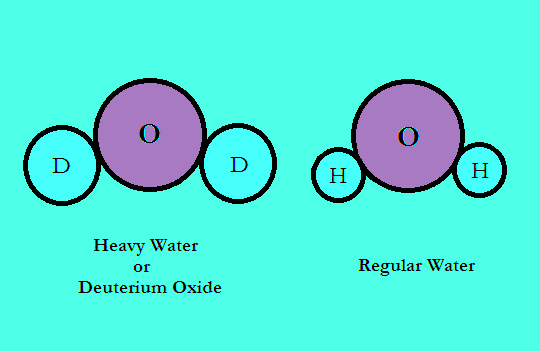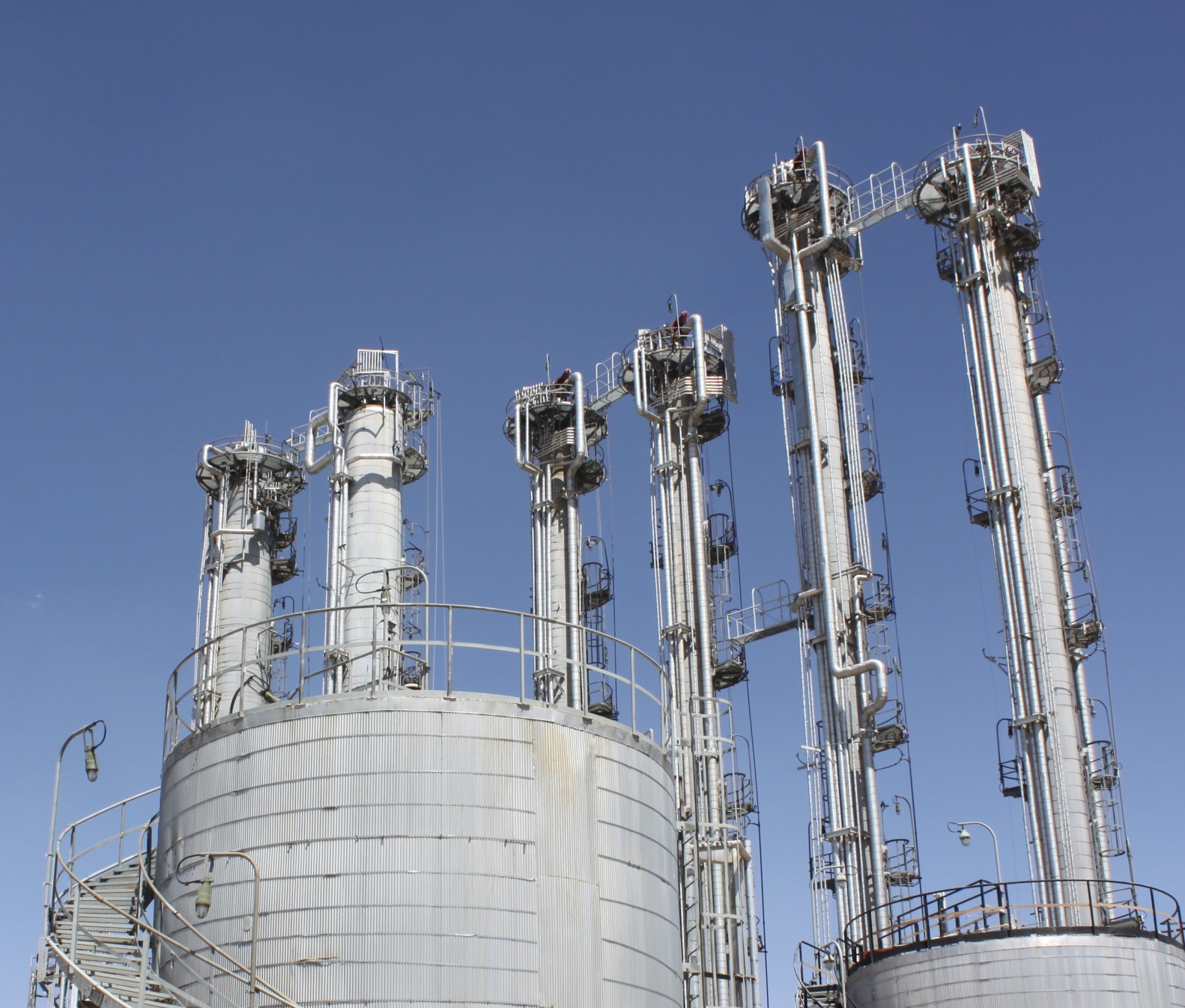What is heavy water?
Heavy water, in simple terms, is water whose hydrogen molecules are exchanged with deuterium (the heavy hydrogen isotope). Therefore, heavy water has a higher boiling point and freezing point than ordinary water. The hydrogen atom has one proton and the deuterium nucleus has one proton and one neutron. This more neutron increases its mass. One mole of ordinary water is 18 grams and heavy water is 20 grams. Therefore, a liter of heavy water has a mass greater than one liter of light water. Due to the difference between the nuclear properties of deuterium and hydrogen in terms of "neutron angular momentum and magnetic moment", heavy water and deuterium are also used in various research fields.

History of heavy water
For the first time, Mr. Russell predicted the existence of deuterium using a helical periodic table. Six years later, in 1931, Harold Yuri of Columbia University discovered it. In 1933, for example, Gilbert Newton-Lewis prepared a sample of pure heavy water by electrolysis. Hossie and Huffer used heavy water in 1944 to conduct environmental tracking experiments to investigate the rate at which water transports through the human body.
How is heavy water produced?
There are various methods including chemical exchange (isotopic), distillation, electrolysis, membrane application, thermal penetration, laser, photochemistry, and adsorption to produce heavy water. Each method has its own advantages and disadvantages and according to the characteristics. So far, only the first three methods have been implemented on an industrial scale. For the first time, the use of the electrolysis (electroplating) method led to the production of heavy water. Since the boiling point of heavy water is higher than ordinary water, evaporation and distillation methods are used to produce it. The difference between the mass of heavy water and light water is considerable and the difference between the boiling points of ordinary water and heavy water is possible. Facilitates the separation of heavy water and its purification. Normally, for every 6,400 to 7,000 ordinary water molecules, there is one heavy water molecule that is physically and chemically purified to produce it.

Heavy water and deuterium applications
The use of heavy water mainly includes two parts: nuclear application and research application (scientific research in the fields of geology, biology, medicine, physics, chemistry, engineering), which we will examine in the following:
Nuclear applications
Neutron Slower: Heavy water is used in some nuclear reactors as a neutron slower. Light water can also be used as a neutron attenuator, but because light water also absorbs thermal neutrons, enriched uranium should be used as fuel in these reactors. But the heavy water reactor can use natural or (unenriched) uranium as fuel. Thus, the production of heavy water is related to the discussion of preventing the proliferation of nuclear weapons. Besides, the use of deuterium and tritium gas for energy production in the fusion process is used. The name helium produces a huge amount of energy.
Non-nuclear applications of heavy water and deuterium
1- Nuclear Magnetic Resonance Spectroscopy: Nowadays, the use of nuclear magnetic resonance spectroscopy (NMR) technique to identify and study the molecular structure is widely used. In this technique, because the signals of the hydrogen atom completely cover the NMR spectrum, heavy water or deuterium solvents are used to study the structure of molecules. Thousands of new compounds are synthesized daily in the world. The first step in identifying these compounds is using the technique. NMR and widespread use of deuterium solvents, the origin of deuterium in deuterium solvents is also heavy.
2. Pharmacy
According to scientists, replacing hydrogen with deuterium improves the properties of drugs and significantly reduces their toxicity. Many companies around the world now produce a variety of deuterium drugs.
3.Use of heavy water in the oil and gas industries:
Today, heavy water is widely used to determine the best location for drilling oil and gas wells and the saturation of such reservoirs.
4. Optical fibers and semiconductors
Another very important application of heavy water is the production of optical fibers and deuterium semiconductors. Replacing deuterium isotopes with hydrogen atoms in these compounds increases their lifespan by up to 10 times and also greatly enhances their electrical properties. Improves a lot. These effects have been such that today leading companies in electronics have started to produce this technology on a commercial level.
5. Deuterium lamp manufacturing industry
These lamps are widely used in spectroscopy devices. In these devices, the source of radiation is deuterium, which provides a continuous source of radiation. A chromatograph menu separates this radiation source and a narrow range of wavelengths is reached to the sample tube by optical instruments. The consumption of deuterium for the production of these lamps is very small, but the price of these lamps is high due to high technology.
6. Neutrino detection. A neutrino detector has been installed deep in the ground in an old mine to prevent cosmic rays from reaching it. The observatory's main goal is to answer the question of whether electron neutrinos produced by fusion in the sun are converted to other types of neutrinos on the way to Earth. Heavy water is essential for these experiments because it provides the deuterium needed to detect a variety of neutrinos.
7- Investigating the energy consumption of living organisms.
A mixture of heavy water with (H218O) water with oxygen whose isotope 18O is used to perform experiments to measure the metabolic rate of humans and animals. This metabolic test is called the DLW "Double Marked Water Test". In this method, the subject first drinks some watermarked with deuterium and oxygen 18 with a specified isotopic concentration.
Then, at specific time intervals, isotopic analysis of D / H and 18O/16O in the urine or saliva sample is performed. Oxygen 18 is excreted from the body in the form of water and carbon dioxide, while deuterium is excreted only in the form of water. Therefore, the difference in the amount of oxygen 18 over a period of time is a reflection of carbon dioxide production. Oxidation of fat is carbohydrate and protein. So the difference in oxygen levels 18 indicates the speed of the body's metabolism.
8- Application of heavy water as a tracer in hydrology
Due to the stability of the deuterium isotope and the absence of any environmental hazard in modern hydrological techniques(stable isotope analysis), by injecting heavy water into groundwater sources, accurate information can be obtained on determining the origin and direction of velocity and direction currents in aquifers. In this method, in groundwater aquifers to determine the path of water movement in porous media, evaluate the groundwater flow velocity, estimate the permeability coefficient of aquifers, origin and feeding ground of groundwater, the relationship of aquifers with each other, and Study of contaminants used.
9_Diagnostic studies in medical science
In general, the basis of nuclear medicine knowledge is the use of radioisotopes and radiopharmaceuticals, and heavy water can be used as a neutron target to produce these materials. Radiopharmaceuticals are used to diagnose and treat diseases such as cancer, benign and malignant tumors, heart failure, and coronary heart disease. For example, in the PET scan technique, labeled glucose or fluorine are widely used. Heavy water is used to label glucose.
Semi-heavy water:
If in the ordinary water molecule (H2O) only one of the hydrogen atoms is converted to the deuterium isotope, then (HDO) or semi-heavy water is produced.
The reason for this is the rapid conversion of hydrogen and deuterium atoms between water molecules. The water molecule, which is composed of 50% ordinary hydrogen (H) and 50% heavy hydrogen (D), will chemically balance about 50% HDO, 25% ordinary water, and 25% D2O(heavy water formula). Had.
can you drink heavy water?
Made by swapping water's hydrogen atoms with their heavier relative, deuterium, heavy water looks and tastes like regular water and in small doses (no more than five tablespoons for humans) is safe to drink
water with heavy oxygen:
Heavily oxygenated water is normally commercially available H218O and is mostly used for tracking.
For example, by replacing this water (by drinking or injecting) in one of the organs of the body, it is possible to check the amount of change in the amount of water in this organ over time.
This type of water rarely contains deuterium and therefore does not have special chemical and biological properties, so it is not called heavy water.
Oxygen may also be present in them as O17 isotopes, however, the only physical difference between this water and ordinary water is its higher density.
Light water:
Light water is water in which the deuterium isotope ratio is lower than normal water. Light water is used to treat and prevent cancer. The main difference between light water and heavy water is in their atomic structure. Light water is actually ordinary pure water with the chemical formula H2O, while heavy water is one of the rare forms of water called deuterium oxide (D2O: heavy water formula), in which two atoms are replaced by two atoms of ordinary hydrogen (H). Heavy hydrogen or deuterium (D) is sitting.
KEYWORD SECTION:
You can also find other articles about the above keywords in other languages with the use of these words.
heavy water deuterium oxide: in RUSSIA тяжелая вода оксид дейтерия | IN CHINESE 重水 氧化氘
IN LATIN gravibus aqua deuterium cadmiae | IN GERMAN schweres Wasser Deuteriumoxid
in french eau lourde oxyde de deutérium | in Italian Acqua pesante ossido di deuterio